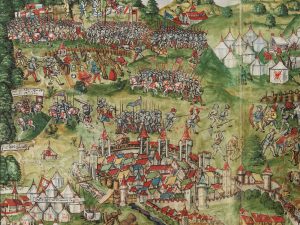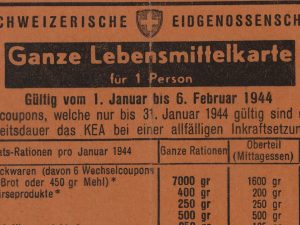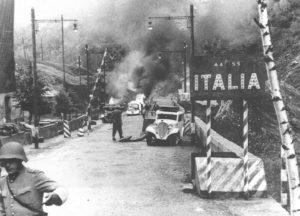
Swiss National Museum / ASL
Ticino during the Second World War
On the border with fascist Italy, things were quite uncomfortable during the Second World War. But despite this, Ticino welcomed refugees with open arms and provided help on numerous occasions.
Large parts of Ticino actively supported the Partisan Republic of Ossola. This didn’t go unnoticed in Italy, and in October 1944 resulted in a counterattack in the press. Milan newspaper Corriere della Sera addressed Switzerland directly on 28 October. In an article entitled ‘Parole chiare agli Svizzeri’, words clearly aimed at the Swiss, the article criticised the country’s support for the resistance. To no avail. Southern Switzerland continued to provide assistance.
Support from the Locarno region was especially vital in the harsh winter of 1944-1945. This assistance was sometimes provided openly, and sometimes more covertly. For example, Mario Pontremoli, a Milanese living in Ascona, repeatedly smuggled resistance fighters back into the Ossola region. He did this by cunning ruses, enhancing his standing not only in the ranks of the partisans, but also among the people of Ticino. Especially in strongly anti-fascist Ascona, Pontremoli’s activities were welcomed. But the Italian was not the only active helper. Vladimir Rosenbaum, a well-known Jewish lawyer, also supported the Ossolan resistance movement. Rosenbaum had fled to Switzerland from Minsk, and quickly made a name for himself as a brilliant lawyer. He represented a number of oil companies, earning a lot of money. Rosenbaum invested this money, among other things, in the struggle against fascism.
In the 1930s Vladimir Rosenbaum had bought a house in Comologno, where he hid, among others, the writer Ignazio Silone. Even before the Second World War, Rosenbaum had been involved in the fight against fascism. During the Spanish Civil War from 1936 and 1939, he had supplied the Republicans with weapons. In 1938 this activity had cost him his licence to practise as a lawyer. He was also sentenced to four months in prison. But after serving his sentence he resumed his fight against fascism, and later also supplied weapons to the partisans in the Ossola region.
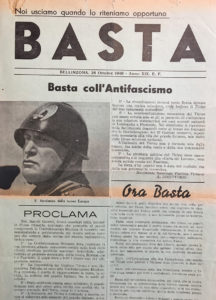
There was also a fascist movement in Ticino. In October 1940, the movement published a piece in its newspaper calling for an end to anti-fascism.
Insubricalhistorica.ch / Raphael Rues
INTERNMENT IN SWITZERLAND
When the Republic of Ossola collapsed on 21 October 1944, the flow of refugees into Switzerland accelerated. Most of the partisans who crossed the border were transported to German-speaking or French-speaking parts of Switzerland and interned there. The camps were located in Schwarzsee, on the Gurnigel and in La Rosiaz. Civilians who had fled, including around 2,500 children, remained in Ticino. They were put up with families or in hotels in Locarno, Brissago or Solduno. Communities and private companies helped provide funding for the relief effort.
They had escaped the war, but the refugees were not able to move around freely in Switzerland. There was a 10 pm to 7 am curfew, cultural activities were only allowed until 8 pm, and public gatherings were banned. Non-compliance earned a warning, and repeat offenders found themselves packed off to internment camps. These rules also applied in Ticino, but the authorities didn’t enforce them quite so rigidly. In contrast to the restrictive federal policy, in Ticino the refugees were taken in without a great deal of bureaucracy. Solidarity was huge among the population, and it helped that the region was not overwhelmed and unable to cope organisationally.
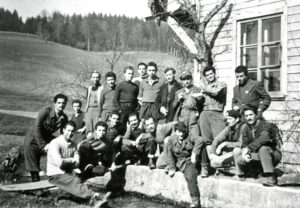
Partisans from the Valdossola division in the Kleindietwil internment camp in the Canton of Bern, spring 1945.
Casa della Resistenza, Centro di Documentazione / Ester Bucchi
SETTLING ACCOUNTS AFTER THE WAR
In March 1945, the end was approaching for Nazi Germany. Attacks by the resistance fighters ramped up again, including in the Ossola region. Many partisans returned to their homeland from Switzerland to fight. The German troops and their fascist Italian allies retreated to the south of the region. The partisans controlled the mountain area. On the evening of 24 April, the well-informed Radio Monte Ceneri announced that a large contingent of German fascist forces had left Domodossola and the upper Ossola region. This finally cleared the way for freedom, and on 8 May 1945 all German troops capitulated.
Scores of Ossolans returned to their homeland after the war. The fact that the region avoided massive retaliatory action was attributed in part to the experiences it had had over a full 40 days in autumn 1944. Unlike many partisan strongholds in Europe, in the Republic of Ossola an administration had quickly been set up and focused on civilian life. To make it work, everyone needed to be pulling in the same direction. The system couldn’t afford significant differences within the population. This attitude prevented further atrocities in May 1945. In Ticino, however, a ‘purge’ of fascists and Nazi sympathisers began. From 8 May 1945 onwards, a number of houses were damaged in Locarno and Ascona, and supporters of Germany and those with links to fascism were hunted down.
Overall, however, the immediate post-war period passed off in relative calm both in Ticino and in the Ossola region. Southern Switzerland’s strong solidarity with the inhabitants of the border area can still be felt today. The help provided during the war years was not forgotten in Italy, and many of the children who were given refuge in Switzerland are still in contact with their ‘host families’.
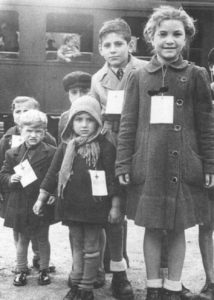
The Red Cross billeted children from the Ossola area with Swiss families. These children arrived in Brig in 1944.
Archivio fotografico Istituto storico Piero Fornara – Fondo Resistenza

Departure of Italian internees, Lausanne, July 1945.
Swiss National Museum / ASL

